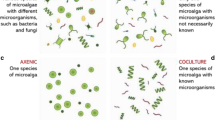Abstract
In order to improve culture stability, as well as to reduce labor andspace for mass production of the marine rotifer Brachionus, an automaticcontinuous culture system has been developed for practical use. The systemconsists of a filtration unit, a culture unit and a harvest unit. In thissystem, filtered water and food are continuously supplied into a rotiferculture tank at a pre-determined rate, and the same amount of culture wateris transferred into a harvest tank to obtain rotifers at a significantbiomass. B. rotundiformis (so-called S-type) and B. plicatilis (so-calledL-type) were successfully mass-produced from the system, under regulatedconditions of 30 °C (for S-type) or 24°C (for L-type), 20 ppt diluted sea water and totaldarkness. As food for rotifers, commercially available concentrated freshwater Chlorella vulgaris was used. The dilution rate was adjusted to0.6–0.7 d−1 for S-type rotifer and 0.25d−1 for L-type rotifer, respectively. The average productionwas about 2.1 billion rotifers d−1 from a 1-m3S-type continuous culture in which high rotifer densities ranging from 3000to 6000 ind. ml−1 were maintained. On the other hand, about0.17 billion rotifers d−1 on average were obtained from a500-liter L-type culture, with densities ranging from 1100 to 2200 ind.ml−1. The longest duration for a continuous culture was over110 days. Furthermore, experiments utilizing five enrichment techniquesindicate that rotifers from the continuous culture system can easily benutritionally enriched in the same manner as those from common batch culturesystems.
Similar content being viewed by others
References
Fushimi, T., 1989. Systematizing large scale culture methods. In Fukusho, K. & K. Hirayama (eds), The First Live Feed Source–Brachionus plicatilis. Koseisha-Koseikaku, Tokyo: 118–134. (In Japanese).
James, C. M.& T. Abu-Rezeq, 1989a. Intensive rotifer cultures using chemostats. Hydrobiologia 186/187: 423–430.
James, C. M. & T. Abu-Rezeq, 1989b. An intensive chemostat culture system for the production of rotifers for aquaculture. Aquaculture 81: 291–301.
James, C. M. & T. Abu-Rezeq, 1990. Efficiency of rotifer chemostats in relation to salinity regimes for producing rotifers for aquaculture. J. aquat. Trop. 5: 103–116.
Kates, M., 1975. Techniques of lipidology. Translated to Japanese by T. Yamakawa, K. Saitho & A. Hayashi, Kagakudoujin, Tokyo: 63–69. (In Japanese).
Nagata, W. D., 1989. Nitrogen flow through a Brachionus/Chlorella mass culture system. Hydrobiologia 186/187: 401–408.
Snell, T. W., 1991. Improving the design of mass culture systems for the rotifer, Brachionus plicatilis. In Fulks, W. & K. L. Main (eds), Rotifer and Microalgae Culture Systems, Proceedings of a U.S.–AsiaWorkshop. The Oceanic Institute, Honolulu, Hawaii: 61–71.
Yoshimura, K., 1995. A high density mass culture system of the rotifer Brachionus rotundiformis(II). Yoshoku, Midorishobo, Tokyo: 116–118. (In Japanese).
Yoshimura, K., K. Usuki, T. Yoshimatsu, C. Kitajima & A. Hagiwara, 1997. Recent development of a high density mass culture system for the rotifer Brachionus rotundiformisTschugunoff. Hydrobiologia 358: 139–144.
Author information
Authors and Affiliations
Rights and permissions
About this article
Cite this article
Fu, Y., Hada, A., Yamashita, T. et al. Development of a continuous culture system for stable mass production of the marine rotifer Brachionus. Hydrobiologia 358, 145–151 (1997). https://doi.org/10.1023/A:1003117430926
Issue Date:
DOI: https://doi.org/10.1023/A:1003117430926




